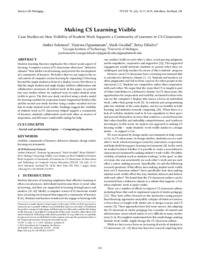Making CS Learning VisibleCase Studies on How Visibility of Student Work Supports a Community of Learners in CS Classrooms
Publikationsdatum:
Zu finden in: ITiCSE 2019, 2019
|
 |
 Zusammenfassungen
Zusammenfassungen

Modern learning theories emphasize the critical social aspect of learning. Computer science (CS) classrooms often have "defensive climates'' that inhibit social learning and prevent the development of a community of learners. We believe that we can improve the social context of computer science learning by expanding CS learning beyond the single student in front of a display screen. Our theory is that the single student and single display inhibits collaboration and collaborative awareness of student work. In this paper, we present two case studies where we explored ways to make student work visible to peers. The first case study involved using a studio model for learning enabled by projection-based Augmented Reality (AR), and the second case study involves using a maker-oriented curriculum to make student work visible. Findings suggest the visibility of student work in CS classrooms helped support a community of learners: students collaborated, used each other as sources of inspiration, and felt more comfortable asking for help.
 Modern learning theories emphasize the critical social aspect of
learning. Computer science (CS) classrooms often have “defensive
climates” that inhibit social learning and prevent the development
of a community of learners. We believe that we can improve the social
context of computer science learning by expanding CS learning
beyond the single student in front of a display screen. Our theory is
that the single student and single display inhibits collaboration and
collaborative awareness of student work. In this paper, we present
two case studies where we explored ways to make student work
visible to peers. The first case study involved using a studio model
for learning enabled by projection-based Augmented Reality (AR),
and the second case study involves using a maker-oriented curriculum
to make student work visible. Findings suggest the visibility
of student work in CS classrooms helped support a community
of learners: students collaborated, used each other as sources of
inspiration, and felt more comfortable asking for help.
Modern learning theories emphasize the critical social aspect of
learning. Computer science (CS) classrooms often have “defensive
climates” that inhibit social learning and prevent the development
of a community of learners. We believe that we can improve the social
context of computer science learning by expanding CS learning
beyond the single student in front of a display screen. Our theory is
that the single student and single display inhibits collaboration and
collaborative awareness of student work. In this paper, we present
two case studies where we explored ways to make student work
visible to peers. The first case study involved using a studio model
for learning enabled by projection-based Augmented Reality (AR),
and the second case study involves using a maker-oriented curriculum
to make student work visible. Findings suggest the visibility
of student work in CS classrooms helped support a community
of learners: students collaborated, used each other as sources of
inspiration, and felt more comfortable asking for help. Dieses Konferenz-Paper erwähnt ...
Dieses Konferenz-Paper erwähnt ...
 Personen KB IB clear | Lecia Barker , Heather E. Bullock , Julian Fernald , Allan Fisher , Kathy Garvin-Doxas , Wendy Hall , Idit Harel , Michele H. Jackson , Jane Margolis , Charlie McDowell , Seymour Papert , Reena Pau , Eric S. Roberts , Etienne Wenger , Linda L. Werner , Su White | ||||||||||||||||||||||||||||||||||||||||||||||||||||||||||||||||||||||||
 Begriffe KB IB clear |  augmented reality augmented reality augmented reality
, Informatikcomputer science
, Informatik-Unterricht (Fachinformatik)Computer Science Education
, Process Oriented Guided Inquiry Learning (POGIL) augmented reality
, Informatikcomputer science
, Informatik-Unterricht (Fachinformatik)Computer Science Education
, Process Oriented Guided Inquiry Learning (POGIL)
| ||||||||||||||||||||||||||||||||||||||||||||||||||||||||||||||||||||||||
 Bücher |
| ||||||||||||||||||||||||||||||||||||||||||||||||||||||||||||||||||||||||
 Texte |
|
 Dieses Konferenz-Paper erwähnt vermutlich nicht ...
Dieses Konferenz-Paper erwähnt vermutlich nicht ... 
 Nicht erwähnte Begriffe | Informatik-Didaktik, Informatikunterricht in der Schule |
 Tagcloud
Tagcloud
 Zitationsgraph
Zitationsgraph
 Zitationsgraph (Beta-Test mit vis.js)
Zitationsgraph (Beta-Test mit vis.js)
 Zeitleiste
Zeitleiste
 Anderswo finden
Anderswo finden
 Volltext dieses Dokuments
Volltext dieses Dokuments
 |  Making CS Learning Visible: Fulltext at the ACM Digital Library ( Making CS Learning Visible: Fulltext at the ACM Digital Library ( : :  , 924 kByte; , 924 kByte;  : :  ) ) |
 Anderswo suchen
Anderswo suchen 
 Beat und dieses Konferenz-Paper
Beat und dieses Konferenz-Paper
Beat hat Dieses Konferenz-Paper während seiner Zeit am Institut für Medien und Schule (IMS) ins Biblionetz aufgenommen. Beat besitzt kein physisches, aber ein digitales Exemplar. Eine digitale Version ist auf dem Internet verfügbar (s.o.). Es gibt bisher nur wenige Objekte im Biblionetz, die dieses Werk zitieren.

















 Biblionetz-History
Biblionetz-History